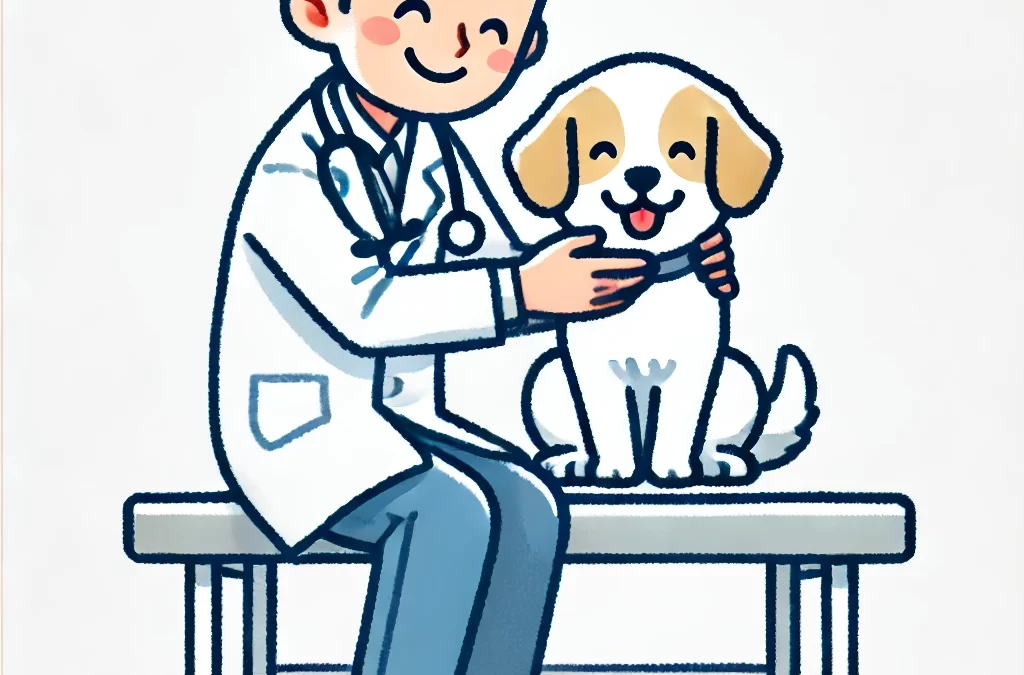
por TCMVET | 30 de noviembre de 2024 | Cáncer y tumores en perros
Cuando a un perro querido le diagnostican cáncer, uno siente que el suelo se ha movido bajo sus pies. Pero en medio de la desesperación, también hay un movimiento creciente de dueños de mascotas, médicos holísticos e investigadores que creen que el cáncer en los perros no tiene por qué ser una sentencia de muerte inmediata. Con la combinación adecuada de terapias, dieta y cambios en el estilo de vida, se puede ralentizar la progresión del cáncer, lo que le dará a su perro más tiempo para disfrutar de la vida con usted a su lado.
Aquí presentamos una nueva perspectiva sobre cómo apoyar la salud de su perro y potencialmente retardar el crecimiento de células cancerosas.
1. Piense más allá de la medicina tradicional
Si bien la quimioterapia y la cirugía son tratamientos estándar para el cáncer en perros, muchos dueños de mascotas ahora buscan terapias complementarias que se centren en reforzar el sistema inmunológico y el bienestar general de su perro. La medicina integrativa, que combina tratamientos convencionales con terapias naturales y alternativas, ha ganado terreno en los últimos años.
Terapias como la acupuntura, los masajes y los tratamientos a base de hierbas pueden ayudar a reducir la inflamación, aliviar el dolor y mejorar la calidad de vida general de su perro. Quizás también desee explorar el mundo de cannabinoides, como el CBD, que ha demostrado ser prometedor en algunos estudios para controlar el dolor y reducir el crecimiento de tumores. Siempre consulte a su veterinario antes de comenzar cualquier terapia alternativa, pero es alentador ver que surgen más opciones.
2. Aproveche el poder de la nutrición
Existe un gran debate en torno a la idea de que lo que le damos a nuestro perro para comer puede influir en su salud, incluida su capacidad para combatir el cáncer. Una dieta que favorezca la lucha contra el cáncer para nuestro perro va más allá de simplemente darle alimentos saludables; se trata de crear un entorno en el cuerpo que dificulte el desarrollo de las células cancerosas.
Algunos nutricionistas recomiendan dietas cetogénicas para perros con cáncer, que son ricos en grasas, moderados en proteínas y bajos en carbohidratos. Este tipo de dieta puede privar a las células cancerosas del azúcar que necesitan para crecer, lo que ralentiza su progresión. superalimentos anticancerígenos Al igual que la cúrcuma, los hongos (shiitake, maitake y reishi) y el extracto de té verde también pueden proporcionar un impulso.
Los lignanos, compuestos que se encuentran en las semillas de lino y otras plantas, se han relacionado con la desaceleración del crecimiento de las células cancerosas en los perros, en particular en casos de linfoma canino. También es posible que desee hablar con su veterinario sobre suplementos como ácidos grasos omega-3, antioxidantes y vitamina D, todos ellos factores que contribuyen a mantener la función inmunológica y favorecer la regeneración celular saludable.
3. Ejercicio y estimulación mental: un equilibrio entre movimiento y descanso
Es fácil suponer que, una vez diagnosticado el cáncer, su perro debe descansar lo máximo posible. Pero, al igual que en los humanos, mantener un equilibrio entre el descanso y la actividad puede ayudar a que el cuerpo de su perro funcione de manera óptima. El ejercicio regular de bajo impacto puede ayudar a mejorar la circulación, reducir el dolor y reforzar el sistema inmunológico de su perro.
La estimulación mental es igualmente importante. Entrenar la mente de tu perro con juguetes interactivos, sesiones de entrenamiento o juegos de olfato puede mejorar su salud mental y su perspectiva general de la vida. Es probable que un perro más feliz y menos estresado esté en mejores condiciones para afrontar los desafíos que trae consigo el cáncer.
4. Un enfoque holístico: la conexión mente-cuerpo
Un aspecto del tratamiento del cáncer que a menudo se pasa por alto, tanto en humanos como en mascotas, es la conexión mente-cuerpo. El estrés y la ansiedad pueden debilitar el sistema inmunológico y crear un entorno en el que las células cancerosas pueden prosperar. Por lo tanto, fomentar un entorno tranquilo y libre de estrés es esencial para el bienestar de su perro.
Considerar prácticas meditativas o crear un santuario en casa donde su perro pueda sentirse seguro y relajado. Esto puede incluir poner música relajante, crear una cama cómoda en una parte tranquila de su casa o incluso aromaterapia con aceites esenciales seguros para mascotas. Es un paso pequeño, pero poderoso, para garantizar que el cuerpo de su perro esté en el mejor estado posible para combatir la enfermedad.
5. Investigación de vanguardia y terapias experimentales
Vivimos en una época apasionante en la que la investigación médica sobre terapias contra el cáncer avanza rápidamente. Si bien el panorama del tratamiento del cáncer canino aún está evolucionando, existen algunos tratamientos nuevos y fascinantes que parecen prometedores, como inmunoterapia y terapia génicaEstas terapias de vanguardia tienen como objetivo activar el sistema inmunológico del perro para combatir el cáncer de manera más efectiva, a menudo apuntando a los tumores con mayor precisión que los métodos tradicionales.
Manténgase informado y defienda a su perro consultando con especialistas que estén al día con los últimos tratamientos y ensayos clínicos. Es posible que pueda brindarle a su perro acceso a terapias que aún no están ampliamente disponibles, todo en un esfuerzo por frenar la progresión del cáncer y mejorar su calidad de vida.
6. El poder del amor y la compasión
Tal vez el aspecto más profundo y a menudo subestimado del tratamiento del cáncer en un perro sea el poder curativo del amor y la conexión emocional. Su presencia, atención y cuidado pueden ser un gran consuelo para su perro, ya que reducen la ansiedad y el estrés, lo que puede ayudar a que su sistema inmunológico funcione de manera más eficaz.
No se trata solo de la comida, los medicamentos o los tratamientos, sino del vínculo que comparten. Esta relación le brinda a su perro la fuerza para luchar, la alegría de vivir y la tranquilidad de saber que lo aman profundamente, pase lo que pase.
Conclusión: cómo frenar el cáncer, paso a paso
El cáncer en los perros es sin duda devastador, pero es importante recordar que existen muchas maneras de frenar su progresión y ayudar a la salud de su perro. Al combinar los tratamientos veterinarios modernos con terapias alternativas, una nutrición adecuada, ejercicio y atención emocional, puede marcar una diferencia significativa en la calidad de vida de su perro.
El camino puede ser largo, pero con un enfoque holístico y un profundo compromiso con el bienestar de su perro, puede ayudarlo a vivir una vida más plena y feliz, una en la que el cáncer no defina su historia, sino el amor y el cuidado que usted le brinda todos los días.

por TCMVET | 29 de noviembre de 2024 | fitoterapia china para mascotas
En lo que respecta a los remedios naturales para perros, Lysimachia 3 es una estrella en ascenso en el cuidado veterinario holístico. Esta fórmula a base de hierbas, que tiene sus raíces en las tradiciones comprobadas de la medicina tradicional china (MTC), está ganando atención por sus posibles beneficios para apoyar la salud canina, en particular para controlar los cálculos en la vejiga, los problemas del tracto urinario y la inflamación. Este artículo ofrece una perspectiva única sobre por qué Lysimachia 3 podría ser el héroe anónimo del camino hacia la salud de su perro.
¿Qué es Lysimachia 3?
Lysimachia 3, también conocida como “Polvo de tres amarillos” en la medicina tradicional china, es una mezcla de tres potentes hierbas:
- Lisimaquia (Jin Qian Cao):Conocido por sus propiedades desintoxicantes y disolventes de cálculos.
- Diente de león (Pu Gong Ying):Un antiinflamatorio y diurético natural.
- Plátano (Che Qian Cao):Apoya la salud del tracto urinario y alivia la irritación.
Esta trilogía de hierbas actúa sinérgicamente para abordar la salud de la vejiga, reducir la inflamación y promover el bienestar general.
¿Por qué considerar Lysimachia 3 para perros?
A diferencia de los productos farmacéuticos, que suelen centrarse en el tratamiento de los síntomas, Lysimachia 3 está diseñado para abordar la causa raíz de los problemas de salud. Este enfoque se alinea con una tendencia creciente entre los dueños de mascotas que buscan soluciones naturales, suaves y efectivas.
Aplicaciones únicas de Lysimachia 3
1. Cálculos y cristales en la vejiga
Lysimachia 3 es famosa por su capacidad para disolver los cálculos de la vejiga y prevenir la formación de cristales urinarios. Sus propiedades para romper los cálculos la convierten en una excelente alternativa para los perros que sufren problemas urinarios recurrentes.
2. Infecciones del tracto urinario
Gracias a sus efectos antibacterianos y antiinflamatorios, la Lysimachia 3 puede ayudar a aliviar los síntomas de las infecciones del tracto urinario (ITU). Alivia el tracto urinario, lo que promueve la curación y reduce las molestias.
3. Desintoxicación
Lysimachia 3 ayuda al hígado y los riñones a eliminar toxinas, lo que lo convierte en un complemento valioso para los protocolos de desintoxicación, especialmente para perros expuestos a toxinas ambientales o a medicamentos a largo plazo.
Cómo utilizar Lysimachia 3 de forma segura en perros
- Consulte a un veterinario:Siempre consulte a un veterinario familiarizado con la medicina herbal antes de introducir Lysimachia 3. Las dosis varían según el tamaño de su perro, su estado de salud y sus necesidades específicas.
- Forma de polvo o cápsula:Las hierbas se pueden administrar en forma de polvo mezclado con la comida o en forma de cápsulas para mayor comodidad.
- Monitor for Reactions:Si bien los efectos secundarios son poco frecuentes, vigile a su perro para detectar cualquier signo de malestar digestivo o reacciones alérgicas.
El renacimiento moderno de los remedios antiguos
En una era dominada por las drogas sintéticas, el resurgimiento de fórmulas a base de hierbas como la Lysimachia 3 es un testimonio de su valor perdurable. La investigación moderna está comenzando a validar lo que los médicos antiguos saben desde hace siglos: la naturaleza tiene soluciones poderosas para la salud.
Por ejemplo:
- Historias de éxito anecdóticas:Los dueños de perros informan mejoras significativas en los síntomas de sus mascotas, desde una reducción del dolor urinario hasta la resolución completa de los cálculos en la vejiga.
- Sinergia con la medicina convencional:Lysimachia 3 puede complementar los tratamientos tradicionales, mejorando su eficacia y reduciendo la dependencia de los antibióticos.
Cuándo considerar la administración de Lysimachia 3 a su perro
Lysimachia 3 no es solo para perros con problemas urinarios o de vejiga activos. También se puede utilizar como medida preventiva para razas propensas a estas afecciones, como los dálmatas o los bulldogs. Además, es una excelente opción para perros que se recuperan de una cirugía de vejiga o de infecciones urinarias crónicas.
¿Es Lysimachia 3 adecuada para su perro?
Lysimachia 3 se destaca como una opción natural y holística para controlar la salud urinaria y de la vejiga en los perros. Su combinación única de hierbas aborda no solo los síntomas, sino también las causas subyacentes, y ofrece una solución integral que se alinea con la preferencia de los dueños de mascotas modernos por el cuidado natural.
Ya sea que esté explorando alternativas a la cirugía, tratando problemas crónicos o simplemente buscando mejorar la salud de su perro, Lysimachia 3 podría ser el aliado herbal que su compañero peludo necesita. Con su rica historia y eficacia comprobada, este antiguo remedio está cobrando protagonismo como una solución moderna para el bienestar canino.

por TCMVET | 29 de noviembre de 2024 | Cáncer y tumores en perros
Cuando se enfrentan a la carga emocional y financiera que supone el diagnóstico de un tumor en un perro, muchos dueños de mascotas se sienten abrumados por los costos asociados con el tratamiento. Sin embargo, la extirpación económica de un tumor en un perro no solo es posible, sino también accesible con los recursos adecuados y un poco de creatividad. Esta guía explora formas únicas y prácticas de garantizar que su amigo peludo reciba la atención que necesita sin afectar su bolsillo.
Comprensión de los tipos de tumores y la necesidad de extirparlos
No todos los tumores requieren una intervención quirúrgica inmediata. Algunos, como los lipomas (tumores grasos benignos), pueden representar una amenaza mínima o nula para la salud de su perro. Consultar con su veterinario para evaluar la naturaleza del tumor es el primer paso para tomar una decisión informada. Si se considera necesaria la extirpación, explore opciones rentables para abordar el problema.
Enfoques creativos para la eliminación asequible de tumores caninos
Escuelas de veterinaria: aprender y ahorrar
Los hospitales veterinarios docentes suelen ofrecer servicios de menor costo, ya que los estudiantes, bajo la guía de profesionales experimentados, realizan los procedimientos. Si bien los costos se reducen, la calidad de la atención sigue siendo alta, lo que hace de esta una excelente opción para los dueños de mascotas que cuidan su presupuesto.
Clínicas veterinarias sin fines de lucro
Muchas organizaciones sin fines de lucro y de protección animal ofrecen atención veterinaria subsidiada, incluida la extirpación de tumores. Busque organizaciones en su área que brinden apoyo a dueños de mascotas de bajos ingresos, como las sucursales de la Sociedad Protectora de Animales o la Sociedad Protectora de Animales de los Estados Unidos, que pueden brindar ayuda financiera.
Plataformas de financiación colectiva
Plataformas como GoFundMe o Waggle permiten a los dueños de mascotas compartir la historia de su perro y recaudar fondos para procedimientos médicos. Una narración sincera y fotografías pueden alentar a los donantes a contribuir al bienestar de su mascota.
Planes de pago con veterinarios locales
Algunas clínicas veterinarias están dispuestas a establecer planes de pago para cirugías costosas. Esta opción le permite distribuir el costo en varios meses, lo que alivia la carga financiera inmediata.
Recuperación y cuidados posteriores por cuenta propia
Si bien la cirugía en sí siempre debe ser realizada por un veterinario autorizado, puede ahorrar dinero si se encarga del cuidado posoperatorio en casa. Aprenda a limpiar heridas, administrar medicamentos y crear un espacio de recuperación cómodo para su perro para minimizar las visitas adicionales a la clínica.
Explorando alternativas: cuando la cirugía no es una opción
Si la cirugía está fuera de sus posibilidades económicas o no se recomienda debido a la salud de su perro, las terapias alternativas pueden ayudar a controlar el tumor. Algunas opciones holísticas incluyen:
- Suplementos herbales: Los remedios naturales como la cúrcuma, el incienso y las fórmulas de la medicina tradicional china como Chuanxiong se han destacado por sus propiedades antiinflamatorias.
- Aceite de CBD: El aceite de CBD de espectro completo puede ayudar a reducir la inflamación y favorecer el bienestar general.
- Ajustes dietéticos: Las dietas anticancerígenas centradas en alimentos integrales, bajos en carbohidratos y ricos en proteínas pueden retardar el crecimiento del tumor.
Medidas preventivas para evitar costos futuros
La atención preventiva puede reducir la probabilidad de formación de tumores. Los controles veterinarios regulares, una dieta equilibrada y evitar la exposición a carcinógenos como el humo del tabaco pueden promover una vida más saludable para su perro. La detección temprana es clave; los tumores pequeños suelen ser más fáciles y menos costosos de tratar que los avanzados.
Compasión e ingenio: las claves para una atención médica asequible
Encontrar opciones de bajo costo para la extirpación de tumores en perros requiere ingenio y determinación. Al aprovechar las organizaciones sin fines de lucro, el apoyo de la comunidad y las terapias alternativas, puede asegurarse de que su perro reciba la atención que necesita sin dificultades económicas. Recuerde, su creatividad y amor por su mascota pueden allanar el camino hacia soluciones compasivas y efectivas.
Ya sea conectándose con una red de proveedores de atención asequibles o adoptando enfoques holísticos, la salud de su perro no tiene por qué tener un costo insuperable. Dejemos que este viaje nos recuerde el vínculo inquebrantable entre las mascotas y sus dueños, una relación que vale la pena.

por TCMVET | 28 de noviembre de 2024 | Cáncer y tumores en perros
Cuando tu perro empieza a cojear o a lamerse las patas excesivamente, el culpable podría ser un quiste interdigital, una afección común y preocupante. Si bien estos quistes suelen ser benignos, su apariencia a veces puede hacer que los dueños de mascotas se pregunten: ¿podría ser un signo de algo más siniestro, como un cáncer? Profundicemos en este tema con nuevos ojos, explorando las distinciones, las posibles conexiones y la mejor manera de abordar estos problemas para el bienestar de tu perro.
¿Qué son los quistes interdigitales?
Los quistes interdigitales, también conocidos como furúnculos, son bultos llenos de líquido que se forman entre los dedos de los pies de un perro. Son el resultado de la inflamación de los folículos pilosos en los espacios interdigitales, a menudo causada por:
- Trauma:Cortes o raspaduras en las patas.
- Alergias:Alergias ambientales o alimentarias que provocan lamido excesivo.
- Predisposiciones genéticas:Ciertas razas, como los Bulldogs y los Labrador Retriever, son más propensas.
- Cuerpos extraños:Astillas o residuos incrustados en la piel.
Si bien los quistes interdigitales generalmente no son cancerosos, su naturaleza recurrente puede causar molestias, infecciones e incluso cojera.
¿Pueden los quistes interdigitales estar relacionados con el cáncer?
La respuesta corta: rara vez, pero no del todo imposible.
La mayoría de los quistes interdigitales son benignos y no están relacionados con el cáncer. Sin embargo, la inflamación crónica causada por quistes persistentes puede crear un entorno propicio para que se presenten afecciones más graves con el tiempo. Este fenómeno, conocido como carcinogénesis provocada por inflamación crónica, destaca cómo la irritación prolongada puede aumentar el riesgo de cambios malignos en los tejidos.
Además, en casos muy raros, los bultos inicialmente identificados como quistes podrían ser en realidad algo más grave, como:
- Squamous Cell Carcinoma (SCC):Un tipo de cáncer de piel que puede desarrollarse en las almohadillas de las patas o entre los dedos.
- Tumores de mastocitos (MCT):Estos tumores, aunque comúnmente se encuentran en otros lugares, ocasionalmente pueden aparecer en lugares inusuales como las patas.
- Melanoma:Los melanomas malignos también pueden manifestarse cerca de las almohadillas de las patas y parecerse a crecimientos similares a quistes.
Cómo diferenciar entre quistes y cáncer
Un diagnóstico adecuado es fundamental. A continuación, se indican los aspectos a tener en cuenta:
- Forma y textura:Los quistes suelen ser blandos, redondos y estar llenos de líquido. Los tumores pueden sentirse duros e irregulares.
- Índice de crecimiento:Los quistes benignos crecen lentamente, mientras que los tumores malignos suelen crecer rápidamente.
- Color y ulceración:Los crecimientos cancerosos pueden decolorarse, ulcerarse o sangrar espontáneamente.
- Respuesta al tratamiento:Los quistes a menudo responden a antibióticos, medicamentos antiinflamatorios o drenaje, mientras que los crecimientos cancerosos no.
Los veterinarios pueden recomendar pruebas de diagnóstico como una aspiración con aguja fina (AAF) o una biopsia para confirmar si un crecimiento es benigno o maligno.
Atención holística y preventiva para la salud de las patas
Incluso si un quiste no es canceroso, la prevención y el cuidado holístico pueden mejorar la calidad de vida de su perro:
- Higiene de las patas:La limpieza regular reduce el riesgo de que objetos extraños se incrusten en las patas de su perro.
- Ajustes dietéticos:Los ácidos grasos omega-3 y los suplementos antiinflamatorios pueden reducir la inflamación y promover la salud de la piel.
- Natural Remedies: Products like TCMVET Baituxiao o las cremas a base de cúrcuma pueden ayudar a reducir la inflamación en los quistes recurrentes.
- Ejercicio moderado:Para perros activos propensos a sufrir traumatismos, considere terrenos más suaves para pasear para evitar cortes y abrasiones.
Cuando se necesita cirugía o tratamiento avanzado
En el caso de quistes persistentes o complicados, puede ser necesaria una intervención quirúrgica para extirpar el tejido afectado. En casos poco frecuentes en los que se sospecha que el cáncer es maligno, puede ser necesaria la amputación del dedo afectado para evitar su propagación. Las terapias avanzadas, como la cirugía láser o la crioterapia, también pueden proporcionar soluciones no invasivas para determinados casos.
La moraleja: el conocimiento es poder
Los quistes interdigitales, aunque son comunes y en su mayoría benignos, nunca deben ignorarse. Mantenerse alerta, consultar a su veterinario y adoptar un enfoque proactivo puede marcar la diferencia para garantizar la salud de las patas de su perro. Y recuerde, incluso si surge el espectro del cáncer, la detección temprana y los tratamientos modernos ofrecen resultados prometedores.
Nuestros amigos peludos dependen de nosotros para recibir cuidados y protección. Si comprendemos los matices de afecciones como los quistes interdigitales, podemos brindarles la mejor oportunidad de tener una vida larga, saludable y feliz.

por TCMVET | 28 de noviembre de 2024 | Cáncer y tumores en perros
Cuando a una mascota querida se le diagnostica un tumor, el peso emocional puede resultar abrumador. La cirugía suele convertirse en el punto focal de la esperanza, pero ¿es siempre la mejor opción? Exploremos el proceso transformador de la cirugía de tumores en mascotas, las alternativas que están cambiando el panorama y cómo la atención holística está redefiniendo la curación de nuestros compañeros peludos.
Una perspectiva histórica: la cirugía como salvavidas
En los inicios de la medicina veterinaria, la cirugía era la respuesta definitiva a los tumores. Con los avances tecnológicos, técnicas como la cirugía láser y la asistencia robótica se han vuelto comunes, lo que hace que los procedimientos sean más seguros y precisos. Por ejemplo, las cirugías oncológicas para mascotas en la actualidad pueden lograr márgenes tan pequeños como un milímetro, preservando el tejido sano mientras se elimina el tumor.
Sin embargo, la vía quirúrgica no está exenta de riesgos. Factores como la edad de la mascota, el tamaño y la ubicación del tumor y las condiciones de salud subyacentes influyen en la tasa de éxito. A pesar de su eficacia para eliminar tumores, la cirugía a menudo aborda solo el síntoma, no la causa raíz.
Las alternativas: un espectro creciente de opciones
Si bien la cirugía sigue siendo una piedra angular, los enfoques alternativos están ganando terreno:
- criocirugía:Utilizando frío extremo para congelar y destruir las células tumorales, este método es menos invasivo e ideal para crecimientos superficiales.
- Terapias dirigidas:Las innovaciones en medicina veterinaria, como la inmunoterapia y los medicamentos moleculares, están permitiendo el tratamiento no quirúrgico de los tumores. Estos tratamientos tienen como objetivo reducir el tamaño de los tumores o ralentizar su progresión.
- Terapias naturales:Remedios a base de hierbas como TCMVET Baituxiao Y los suplementos a base de cáñamo se están volviendo populares por su capacidad para apoyar el sistema inmunológico e inhibir el crecimiento de tumores con efectos secundarios mínimos.
- Cuidados paliativos:Para las mascotas con tumores inoperables, la comodidad se convierte en la prioridad. El manejo del dolor, los ajustes dietéticos y la fisioterapia desempeñan un papel fundamental en el mantenimiento de la calidad de vida.
Sopesando la decisión: ¿Recortar o no recortar?
La elección de una cirugía o una alternativa depende de múltiples factores:
- Tipo de tumor:Los tumores benignos pueden no requerir cirugía inmediata, mientras que los crecimientos malignos a menudo requieren una acción rápida.
- Calidad de vida¿Es probable que el procedimiento mejore el bienestar de la mascota o podría provocarle estrés y dolor indebidos?
- Objetivos del propietario:Algunos propietarios priorizan la longevidad, mientras que otros se centran en la comodidad y el cuidado integral.
La consulta con un oncólogo veterinario es vital para garantizar un plan de tratamiento personalizado que considere las necesidades únicas de la mascota.
Sanación holística: más allá del bisturí
El cuidado posoperatorio es tan importante como el procedimiento en sí. Cada vez más, se están integrando métodos holísticos en los planes de recuperación:
- Terapia nutricionalLas dietas ricas en antioxidantes, ácidos grasos omega-3 y compuestos que combaten el cáncer son fundamentales.
- Acupuntura y Masaje:Estas terapias pueden aliviar el dolor, estimular la circulación y acelerar la curación.
- Soporte emocional:Las mascotas, al igual que los humanos, se benefician de un entorno libre de estrés durante la recuperación. Pasar tiempo de calidad, participar en juegos suaves y mantener rutinas puede mejorar su estado de ánimo.
El futuro de la cirugía de tumores en mascotas
El campo de la oncología veterinaria está evolucionando rápidamente. Innovaciones como los diagnósticos guiados por IA y las herramientas quirúrgicas impresas en 3D prometen intervenciones aún más precisas y efectivas. Además, la investigación sobre la base genética de los tumores en las mascotas está allanando el camino para las estrategias preventivas.
A medida que se producen estos avances, la narrativa en torno a la cirugía de tumores en mascotas está cambiando: del miedo a la esperanza, del cuidado reactivo al proactivo.
Una reflexión final
Ya sea que optemos por la cirugía o que exploremos alternativas, el objetivo final siempre es el mismo: brindarles a nuestras mascotas la mejor vida posible. Con compasión, toma de decisiones informada y acceso a atención de vanguardia, podemos superar este difícil capítulo y salir fortalecidos, juntos.
Cuando se enfrenta a un diagnóstico de tumor, recuerde: usted es el defensor y el mayor defensor de su mascota. Cada decisión que toma proviene del amor y eso marca la diferencia.





